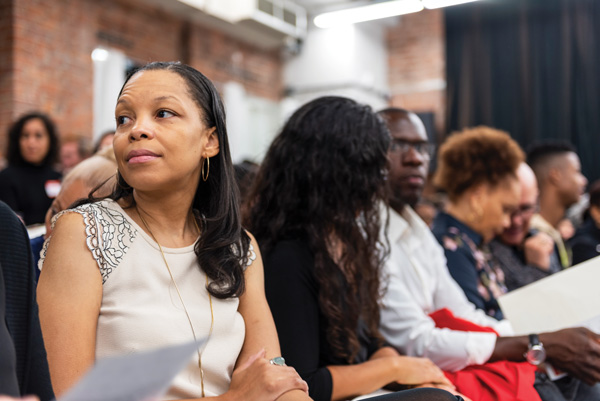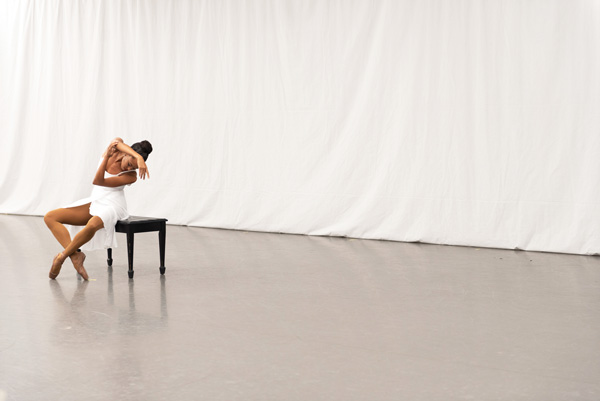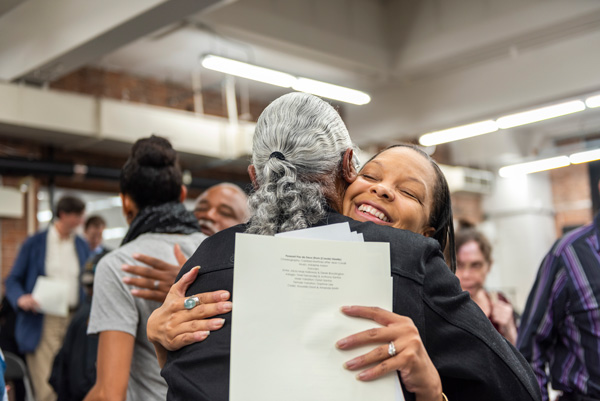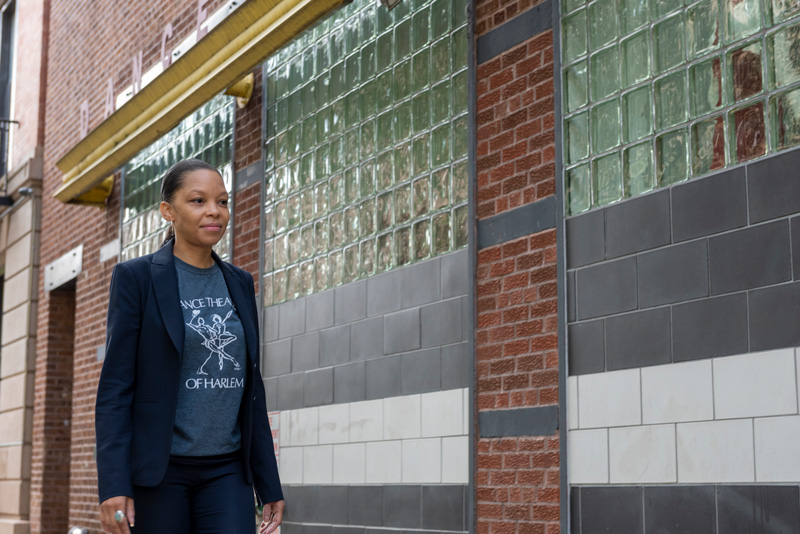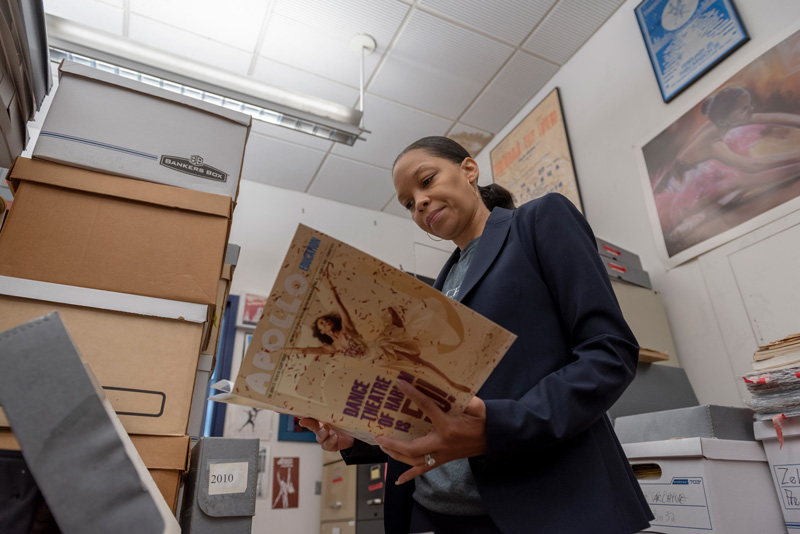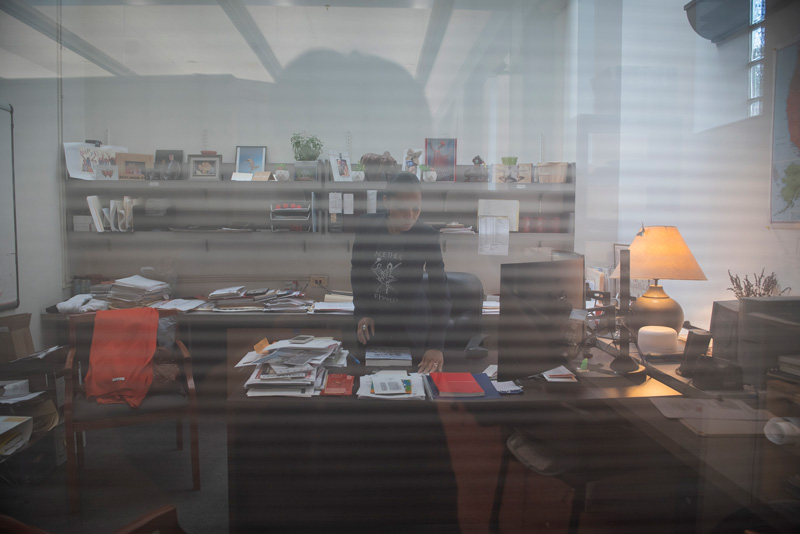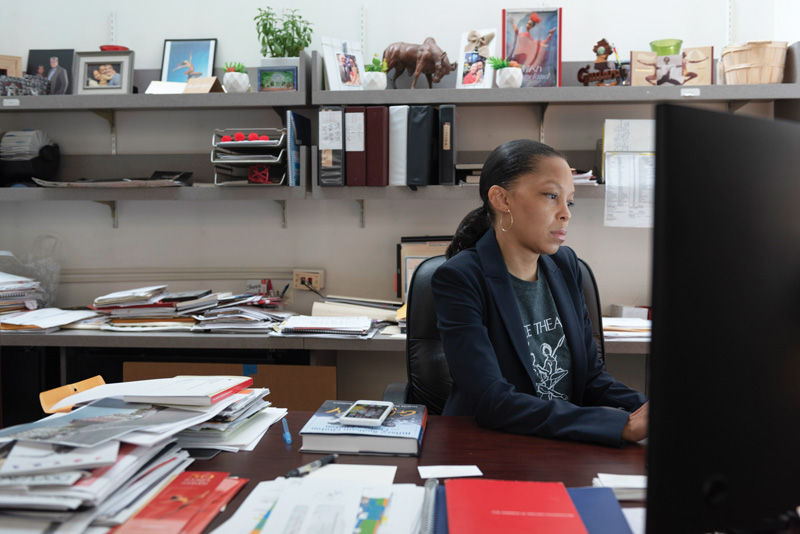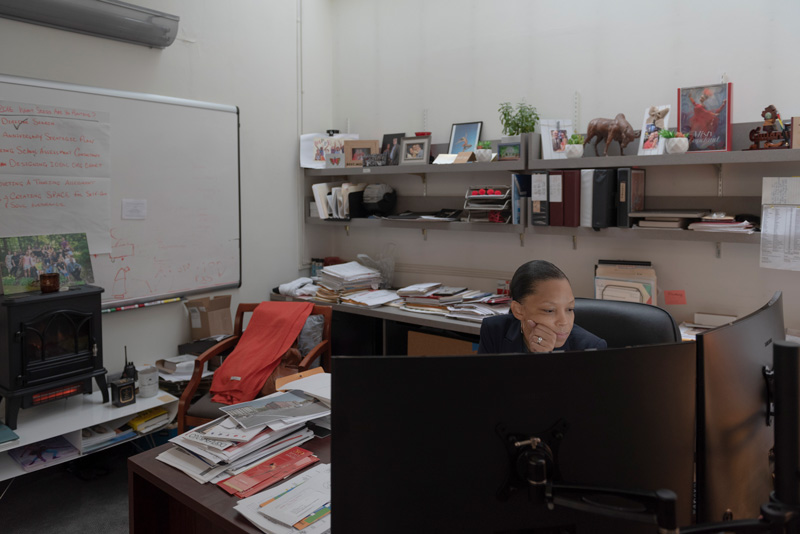Pointe person
It was as if she was living two lives. During the day, Anna Glass attended law school; at night, she traded her books for a leotard and a barre. With a dazed expression and at a rare loss for words, Glass remembered the days she juggled law school and dance with a mix of awe and stupefaction.
“I don’t even know how I made it through,” she said. “When I look back, I’m like, that was the craziest thing I ever did.”
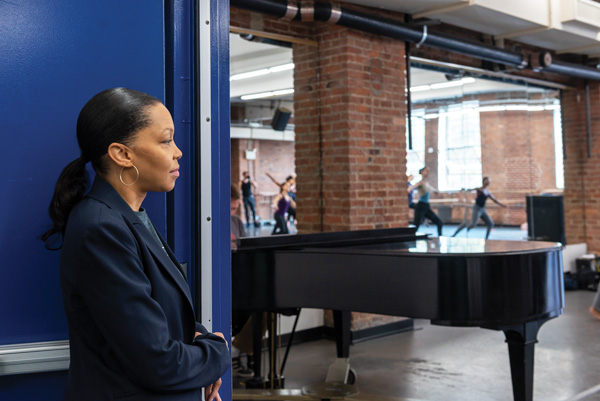 Glass graduated from the University of Dayton School of Law in 1999, having spent her student days living a dual life as a performing member of the Dayton Contemporary Dance Company’s pre-professional company. While she has never practiced law, her degree, along with her dancing history, have served her well.
Glass graduated from the University of Dayton School of Law in 1999, having spent her student days living a dual life as a performing member of the Dayton Contemporary Dance Company’s pre-professional company. While she has never practiced law, her degree, along with her dancing history, have served her well.
Over the years, she has held leadership roles in the arts, including her present and most important one: executive director of Dance Theatre of Harlem, a company inspired by the civil rights movement and formed by Arthur Mitchell and Karel Shook. It’s been called a national treasure, with its message of empowerment through the arts for all.
But even treasures can find themselves in peril.
Because of her education and devotion to dance, Glass found herself in a position to help save it.
Real place
Mitchell, the first African American principal dancer at New York City Ballet, took stock of his life after the assassination of Martin Luther King Jr. Even though he was in his prime, he decided to leave the comforts of City Ballet — where his mentor, George Balanchine, created the groundbreaking 1957 ballet “Agon” for Mitchell and Diana Adams, a white dancer — to start a company of his own. Dance Theatre of Harlem went on to prove to the world that a dancer, regardless of race, could master ballet.
But after decades of robust touring, the company’s financial health was in peril; from 2004 to 2012, it went on hiatus due to financial difficulties, and for its 2013 rebirth, the group was smaller by necessity. Virginia Johnson, a founding member and star ballerina, took over as its artistic director.
Glass entered through more of a side door: In 2014, she received a request from the Ford Foundation, among the largest private American foundations and a major force in influencing American culture, especially in the areas of diversity and equality. It asked her to assess the company amid rumors that it was, once again, on shaky financial ground.
While it was meant to be a temporary job, she never left.
“I think what happened was that she fell in love,” Johnson said. “She was just like, ‘Okay, I get it. This place has got some problems, but this place is real. This place needs to be.’”
Over the years, but especially now — Dance Theatre remains small, but is stable — Glass has proven herself to be a critical part of the dance world. And while some executive directors have a staid, overly bureaucratic air, Glass is different: She’s real, with a ready smile, dancing eyes and a habit of changing the subject with an endearing “anyhoo.” Small and elegant, she still looks like a dancer; if she were to wear a leotard as she roamed the halls of the company’s Harlem headquarters, you wouldn’t bat an eye.
From dance to law
It’s fitting that she started out as a dancer. Born in Saginaw, Michigan, Glass began training in tap and jazz at a small studio; she was 6 and loved it. Moving on, she studied ballet at the Flint Institute of Music, a 30-minute drive from Saginaw.
“I would do my homework in the car and eat fast food for dinner,” she said. “It was a lot. Finally, my mom told me about Interlochen Arts Academy.”
She attended the fine arts boarding school in northern Michigan for her freshman and sophomore years of high school; when her family relocated to the Detroit area, she went with them and “went to some ridiculous all-girls school,” she said.
“In hindsight, I should have stayed my butt there.”
“In hindsight, I should have stayed my butt there, but you know when you’re young you’re just like, my family’s leaving — I wanted to go with them.”
But there was something else that made her leave Interlochen: Out of about 50 students in the dance program, only three were black. Glass had an encounter with a woman — she doesn’t recall if she was a ballet teacher or not — who told her that she didn’t have a future in dance.
“Not because of my talent, but because my only options would be to join Ailey” — she said, referring to Alvin Ailey American Dance Theater, whose dance is rooted in African American tradition — “or Dance Theatre of Harlem and outside of that, ‘No one is really going to pick you up,’” Glass said. “I remember just thinking, oh, that makes me sad that I only have two options, and all of my friends have a gazillion options. I just believed it. I didn’t even argue against it.”
And that was the end of her dance training — until she got to Oberlin College where, while pursuing a history degree, Glass rediscovered dance. She made it her minor and was, once again, consumed.
“I’d come to New York (city) for the summer and study at Ailey, and when I was getting ready to graduate, my parents — they were a wonderful, old-school black family — were like, ‘You’re going to pursue this dancing?’” she said. “‘What happens if you break your leg? How are you going to live?’”
She made a deal with them: She would pursue her career with Dayton Contemporary Dance Co. and apply to a single law school, the University of Dayton.
“If I didn’t get in, they had to get off my back,” she said.
Not only was she accepted, but she was awarded a full scholarship. “I was like, OK!” she said. “I guess I’ll go to law school.”
It meant scrimping on sleep, reading textbooks in theater wings and as much as she could — because first-year law students aren’t allowed to have jobs on the side — keeping her dancing a secret. But she did have a study group, which she described as “a bunch of white guys” who in retrospect were a critical part of her success.
“I don’t know what possessed them to support me in the way that they did,” she said. “I’ll have to ask them. But that’s how I stayed on top.”
She also had an integral mentor in Jeraldyne Blunden, DCDC’s founder. Blunden formed the company in 1968 to provide performance opportunities for dancers of color. For Blunden, it was crucial that Glass graduate.
Glass recalled Blunden saying, “You’re a great and beautiful dancer, but you’re going to be more valuable to me as a lawyer. I don’t have anyone like you in my corner.”
And back again
Glass has a vivid memory of sitting in her employment law class and being sure of one thing: She was not going to join a firm. After graduating in 1999, Glass moved to New York City to pursue a dance career, yet that dream didn’t last long.
“The law school experience impacted me in a weird way because now I had all this knowledge,” she said. “I felt like I couldn’t just be a dancer with all of this information. I couldn’t live in such a narrowly focused existence.”
Glass was making a living through temp work when Blunden asked her to become the booking agent for DCDC. The company found Glass a position at the artist services organization Pentacle; eventually she reached a point where she wanted to learn more.
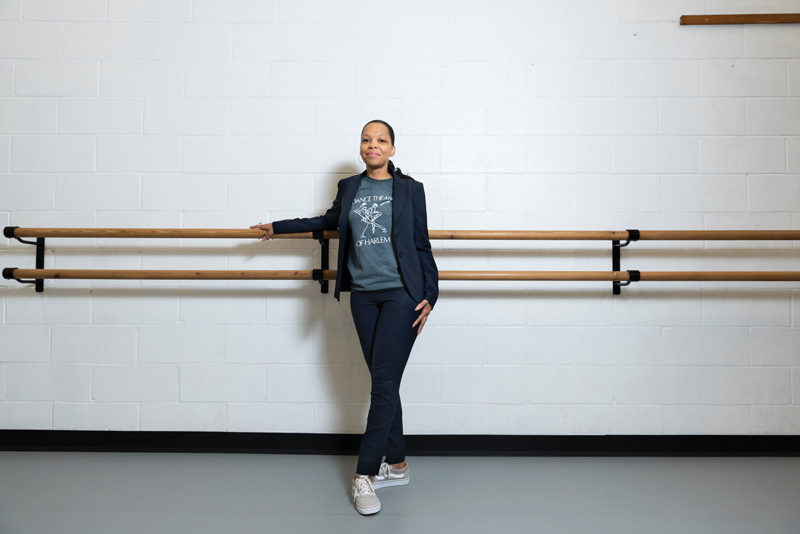 In 2003, Glass was accepted into a yearlong fellowship program under Michael Kaiser at the Kennedy Center, the nation’s busiest performing arts center, attracting more than 2 million audience members a year to Washington, D.C. Kaiser is revered for turning around arts organizations, including American Ballet Theatre and the Ailey company; he once called Dance Theatre of Harlem “truly a national treasure.” Glass is one of two people in the history of the program to work directly with him; he taught her to understand that the artistic product comes first.
In 2003, Glass was accepted into a yearlong fellowship program under Michael Kaiser at the Kennedy Center, the nation’s busiest performing arts center, attracting more than 2 million audience members a year to Washington, D.C. Kaiser is revered for turning around arts organizations, including American Ballet Theatre and the Ailey company; he once called Dance Theatre of Harlem “truly a national treasure.” Glass is one of two people in the history of the program to work directly with him; he taught her to understand that the artistic product comes first.
A key moment came when Kaiser asked Glass if she planned to work exclusively with black organizations. “I remember feeling really conflicted about that question, because of course you want the answer to be no,” she said. “But I was starting to really develop some clarity around the things that were important to me, and it was working for arts organizations that, at the time, I would have called ‘culturally specific.’ But if I was really straight about it, it would be black institutions.”
Glass entered the fold of 651 Arts — a Brooklyn organization devoted to contemporary dance, theater and music that comes from the African diaspora — as its managing director. While there, she met Carmen de Lavallade, the actress, dancer and choreographer who is considered to be something like dance royalty. A Kennedy Center Honors Award recipient in 2017, de Lavallade was married to the late Geoffrey Holder, a director, choreographer and artist; her cousin was Janet Collins, the first black ballerina to perform at the Metropolitan Opera. And de Lavallade, who started dancing as a teenager in Los Angeles, was the person who introduced the choreographer Alvin Ailey to dance.
“I’m not getting any younger: Can we do this show?”
When Glass, after eight years, left 651 to have a child and embark on a freelance career creating strategic plans, she got a call: “Carmen was like, ‘I’m not getting any younger: Can we do this show?’”
It turned out to be As I Remember It, a 2014 solo that Glass produced that explored de Lavallade’s rich history in dance. The show was still touring when Darren Walker, the president of the Ford Foundation, asked Glass to take a look at what was going on with Dance Theatre of Harlem. She created a report that pointed out some issues concerning the financial management of the organization.
“Basically the budget is a hot mess, the accounting software makes no sense and nothing relates to actually how the organization is operating,” she said. “So it’s impossible to really understand what the current state of the union is because the financial management is crazy.”
She also told him that there was confusion within Dance Theatre of Harlem about where it was headed. “Darren said, ‘Yeah, that’s what I thought was happening. Now I need you to fix it.’ I’m like, what?”
Survive, thrive
Glass had never run a dance company; she called on Sharon Luckman, the former executive director of Alvin Ailey American Dance Theater, for help, even though they didn’t know each other. As they uncovered information about the institution’s financial state, they became worried. “Sharon and I were really doing our best to figure out how to keep the doors open: Is it a merger? What do we have to do to make sure this institution survives?”
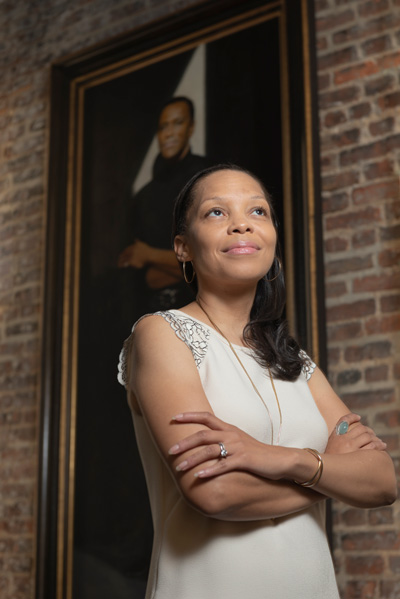 But something strange happened that year. Instead of ending the year in a deficit, there was a $200,000 surplus. Part of it had to do with the decision to move the company’s New York City season from Jazz at Lincoln Center to City Center, which is recognized as more of a dance venue. Because of that, Dance Theatre of Harlem didn’t need to seek out audiences; audiences came to them.
But something strange happened that year. Instead of ending the year in a deficit, there was a $200,000 surplus. Part of it had to do with the decision to move the company’s New York City season from Jazz at Lincoln Center to City Center, which is recognized as more of a dance venue. Because of that, Dance Theatre of Harlem didn’t need to seek out audiences; audiences came to them.
“We created a budget that we still use now,” Glass said. “I brought in a new finance team. The truth of the matter is that it became not about what DTH was doing, it was how DTH was doing what it was doing. The [DTH dance] school — it might as well have been 1980. We weren’t doing online tuition payments and so we would have parents who weren’t paying their tuition bills and we wouldn’t have any clue that that wasn’t happening.”
Little things, in other words, add up. Now that Robert Garland, the company’s resident choreographer, is in charge of the school, enrollment has gone up.
“Anna knows how to look at a problem and walk around it and figure out where the point of entry is,” Johnson said. “That’s really valuable, because there are nothing but problems in a ballet company — it’s just nothing but. She’s also creative: What is the way to make that an advantage rather than a disadvantage?”
Apparently Mitchell, who died in 2018, had a sense of that early on. He originally wanted Glass to come on as executive director when he was still running the company. They first met when she was 30 and about to leave the Kennedy Center program. She insisted she wasn’t ready.
“He was like, ‘Oh, I’ll get you ready,’” she said. “I had heard that it was very challenging to work with Mr. Mitchell, and I didn’t feel like I had enough experience to manage him and to be in a role this big, so I turned him down, but I kept in touch with him.”
When she was at 651, they spent time together, and when she finally did end up at Dance Theatre, he was pleased. And on her end, Glass delivered, helping to lead a successful fundraising effort in 2019 to celebrate the company’s 50th anniversary that also paid homage to Mitchell’s legacy. And even though Mitchell was no longer involved in running the company, he was — and still is — an influence.
For example, there was an issue in the dance school with a parent who had a grievance against a teacher. “I had not run a school before,” Glass said, “and I remember saying, ‘Mr. Mitchell, how would you have handled this?’ And he said, ‘Well, I would have told them to go to Ailey.’ And he was dead serious.”
"It’s OK if the answer to something is that it’s not going to work."
She was astonished. Her aim was to salvage the situation, to make sure that the parent wouldn’t leave the school. “I was like, ‘Really?’” Glass recalled, “He said, ‘Listen here, sweetheart: You’re not going to last very long if you let these people bother you.’ And I have held onto that. When things get crazy or something’s upsetting me, I just remember what Mr. Mitchell said: It’s OK if the answer to something is that it’s not going to work.”
And the influence of DCDC founder Blunden is still present in Glass’ decision to work to uphold the legacy of black artists and cultural institutions, to treasure both the art and the organization that makes it possible. When she was dancing for Blunden, Glass was surrounded by choreographers like Eleo Pomare and Donald McKayle. “All of these amazing, legendary artists were hanging out in Dayton, Ohio,” Glass said. “Jeraldyne really instilled this sense of respect for that: To pay attention to history and to revere it and to fight for it. It’s why I gravitated toward Carmen. And it’s why I’m at Dance Theatre of Harlem.”
Gia Kourlas is the dance critic of The New York Times. Zoe Xia is a former student photographer at UD Magazine. Based for several years in New York City, she is now taking photos in China.
